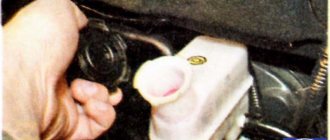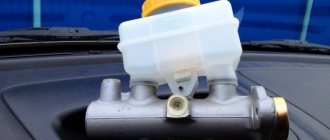Water froze in the washer reservoir: what to do
If the water in the windshield washer reservoir is frozen, there is no need to panic. Nothing terrible or irreparable happened. First of all, you need to assess the scale of the problem:
- how much frozen washer fluid is in the tank;
- How frozen the system is (is there ice in the motor and lines).
First, check the ice level in the tank. This can often be done visually by simply looking into the plug or at the level indicator. But in some cars the tank is hidden from view. Then you will need to acquire some thin and elastic metal object to launch it into the tank through the neck. An oil dipstick may be useful for this procedure. Just before immersing it in the tank you need to wipe it free of oil.
We feel and disconnect the lines connecting the motor and the injectors on the hood. Windshield washer lines are usually attached to the inside surface of the hood. A good sign is if the liquid in the tubes is not frozen. The mains are frozen - only heating with heat from outside will help.
Let's try spraying it on the glass. If the motor does not work, that is, when you press the washer lever or button, you do not hear a characteristic buzzing sound, then the system is completely frozen. In this case, it is highly recommended not to try to turn the motor. It can simply fail.
After the evaluation procedures, we select one of the most suitable methods for defrosting the water in the tank.
Snowball game. What to do if the windshield washer freezes?
The sudden onset of frost took many car enthusiasts by surprise, including journalists from our editorial office. The not-so-low-temperature washers that were filled in at the beginning of winter froze in the tanks, hoses and nozzles. Stopping near every snowdrift for a handful of snow for the windshield is never an option! How to defrost a windshield washer?
Method No. 1. From personal experience
In my case, the problem was solved by a long trip around the city and filling with low-temperature washer fluid. I was lucky most likely because the old fluid in the tank was almost gone, and the new one simply “melted” the remnants of the old one.
However, to find a liquid that freezes at temperatures below -20°C, I had to visit two supermarkets and three gas stations. All crushed! At one of the gas stations there was no anti-freeze liquid at all, and only at the last gas station was it possible to steal the last container of Krugozor from the display case with a temperature threshold below -25°C. Why weren’t shopping centers and gas stations prepared for the booming demand for washer fluids? Were you expecting global warming? Didn't wait...
In general, the method is clear. If there was little old fluid in the washer reservoir, simply pour in new fluid, but with a low freezing point. You can try to find a “wash” for harsh winters or pour in the most frost-resistant concentrate. But personally, I didn’t find anything below -25°C in five retail outlets.
What should I put in the washer reservoir? Our author Sergei Boyarskikh recently tested anti-freeze liquids - “Testing “anti-freeze”: which will freeze, which will not?
Method No. 2. “Pour vodka into the tanks, otherwise we won’t leave!”
Remember “Peculiarities of National Fishing”, where the heroes poured vodka into the tanks of the submarine? The principle is approximately the same: pour alcohol or vodka into the system - they will defrost the water in the tank. But there will be such a smell from the alcohol in the washer that if the traffic police stops you, then, quite possibly, the inspector will offer to take an alcohol test.
It is clear that it is morally difficult for our person to do this. But it is necessary, Fedya, it is necessary!
Method No. 3. “Sleep” in a warm room
It’s a pity you can’t, like in the cartoon about Prostokvashino, drag a car into an ordinary apartment. And if such a number will still work with the Peel P50, then with the Hyundai Accent, alas, it won’t.
The method is as follows: you need to leave the car in a heated garage or warm parking lot. To warm up the engine compartment, let the engine idle, which will speed up the process of defrosting the system. In the morning you just need to drain the old fluid and add new one.
By the way, if the reservoir is located near the engine, you can try to fill it with the same washer fluid for harsh winters and drive the car for a long time. But if it is located somewhere near the front bumper, then driving and warming up the car is useless.
Although it is still better to warm up the car well: the heat in the engine compartment will help to thaw the hoses of the windshield washer system.
Finding warm parking, it turns out, is also a problem. At an outside temperature of -18°C in the underground parking of the Skala shopping center near the metro station. “Sports” the on-board computer showed -10°C. This is unlikely to be enough to defrost the washer. But it’s warm in the Stolitsa shopping center. The prices here are quite affordable: holding a car for 2 hours costs 35,000, 3 hours - 40,000 rubles. For each subsequent hour, plus 3,000 accrues, and a day in the parking lot will cost 103,000 rubles.
Method number 4. Radical
The method seems to be the simplest: remove the tank and put it in a heated garage overnight or bring it home. This is if the tank is located in an easily accessible place, but often to dismantle it you need to remove some parts like the fender liner or bumper, which is labor-intensive and uncomfortable in the cold. But if they took it off, good. You can speed up the process by placing the tank on the battery or rinsing it with hot water, but not boiling water.
If the pipes and injectors are frozen and you have a garage, warm up the system with a hairdryer.
By the way, if the system itself is frozen and there is no hairdryer, you can disconnect the washer hoses and inject a special liquid into them to defrost the locks. Or the same alcohol. It is important that the engine is warmed up at this point - in a warm engine compartment, the supply tubes will quickly warm up and the ice in them will melt. When the washer starts working, do not spare the system - not only in the tank, but also in the pump, tubes, and nozzles there should be not water, but non-freezing liquid.
Another simple life hack - the nozzles can be cleaned and adjusted with a simple needle. Always keep it in the glove compartment or behind your visor.
How to drain old fluid from the washer fluid reservoir?
So, you have finally defrosted the washer fluid in the reservoir. Now it must be drained, and it does not matter at all what kind of substance it was previously - simple water or a special liquid. It will have to be replaced in any case, now it is imperative to use an “anti-freeze” one. How can I drain this liquid without removing the reservoir? We find the connection point of the hoses in the tank - you can carefully warm the connection point with a lighter - and disconnect it. We insert one end of the hose that comes out of the tank into a regular plastic bottle, start the engine and turn on the washer - all the liquid will flow into the bottle. Now feel free to fill in the “anti-freeze”. One note: if your car has headlight washers, make sure the headlights are turned off.
The liquid can also be drained using a piece of hose through the top, causing the necessary vacuum in it. The main thing is not to get poisoned by this crap.
If there is not much liquid, then we simply turn on the heater motor and wait until the liquid pours onto the glass.
Method No. 5. Hot water
If you didn’t have much liquid in the tank, you can fill it with hot water (not to the brim) and wait until the ice melts. Drain the old fluid and add a good anti-freeze solution. But the method is controversial. Firstly, you cannot pour boiling water, since a large temperature difference can cause the tank to become deformed. Secondly, if the old liquid does not melt, then we get several more liters of ice in the washer... If the liquid in the reservoir has melted, but nothing is still pouring onto the glass, then you need to pour hot water over the washer system tubes.
Method number 6. Combined
All previous methods can be combined at your discretion. But here is one of the interesting and quick solutions.
We go to the store and buy a high-quality “anti-freeze” that has the lowest possible temperature threshold. Next, we warm up the car to the maximum and heat the “anti-freeze” in any convenient way. When both the car and the anti-freeze system have warmed up sufficiently, add the heated liquid to the tank and drive to a warm room. Place the container with non-freezing liquid in a warm place where the air flow from the stove is directed. Upon arrival at your destination, take a container of liquid and add it to the tank, where space has become free due to the melting of ice (as you know, ice takes up more volume than water).
While the car is in a warm room and the defrosting process is in progress, you can go shopping and make the necessary purchases. After about two to four hours, depending on the amount of ice in the tank, the entire system should defrost, the pipes and nozzles should melt. After this, you need to drain all the water from the windshield washer reservoir and fill it with the liquid that was in the car.
Method No. 7. Boiler
You can try to melt the tank using a boiler. But a number of problems arise. The boiler must be very compact so that it fits into the filler neck. The tank can be damaged, you need a 220 volt power supply, etc. and so on. - in general, a dreary matter.
That's all for us. We tested how these methods work in practice back in 2007. Read about this in Ivan Kriskevich’s material “Three approaches to defrosting.”
Yuri GLADCHUK Photos by the author and from open sources ABW.BY
What tips can you give for defrosting the windshield washer? Leave your messages on the forum
How to “defrost” the windshield washer system in a car?
It’s no secret: winter comes unexpectedly in Russia. Just last night I left the car in the yard at above-zero temperatures, returned in the morning and found a large snowdrift in its place.
There are two things that terrify a motorist in winter. The first concerns starting the engine, the second concerns the operation of the window washer system. There is nothing worse on the road than frozen washer pipes. What to do if this does happen: you press the button, but there are no magical jets watering the glass for a better view? How to defrost washer?
First, you should know that if your washer doesn't work, it can be extremely dangerous to hit the road. Even if the asphalt is dry, the sun is shining in the morning and there is not a single cloud in the sky, by the evening the weather may change - it will snow or rain. Especially in winter, when cars passing along the road continuously lift into the air a snow-salt suspension richly flavored with chemical compounds (in particular, reagents). In such weather, the windshield gets dirty “once or twice” and visibility from the driver’s seat drops to almost zero. It is not safe!
What does the driver do if the washer does not work? He gets up from his seat, pressing his chest against the steering wheel, and pressing his nose against the glass, in the hope of discerning what is happening in front of the hood. A more cautious motorist stops at the sidewalk and tries to clean the glass - spraying water from a bottle or gray snow from the side of the road onto it, rubbing a rag blackened with oil and grease over the surface. And the result? Almost zero.
What will a smart driver do? He will not set off without making sure that the glass washer system is working and that the level of washer fluid in the tank is sufficient to get to the place (and, ideally, also to return back). There are several simple techniques for defrosting the system.
The easiest and at the same time the most difficult way to defrost the washer is to send the car to a warm room. For example, to the garage. If there is no garage, you can use the underground parking of the nearest hypermarket. It is not heated, so it will take longer to defrost the system than in a warm garage. And yet this is the most obvious and simple way out for residents of large cities. To avoid wasting time, go to the store and make the necessary purchases.
A regular car wash can replace a hypermarket. 20-30 minutes while your car is being washed is enough to defrost the washer system pipes. A clean body is an added bonus.
Those who drove a Zhiguli for many years before buying a foreign car know that a bottle of warm water will help solve the problem. Remember: the water should not be either cold or very hot. Boiling water poured into the tank can melt plastic parts and connections.
A few minutes will pass and the ice in the tank will melt. Do not forget to drain the water from the tank, otherwise it will freeze again and the problem will return - you will have to defrost the washer again. The water must be drained immediately after the pump starts running. What's next? And then you fill the tank with anti-freeze, purchased in advance, pump the liquid through the system (to squeeze out the remaining water from it) and live “happily ever after.”
What to do if the antifreeze is frozen
There are several solutions to the problem. The most reliable way is to put the car in a well-heated place (personal garage or parking lot), and then wait for the ice to thaw. There are cases when spending 2-3 hours is a luxury, for example, if you are in a hurry to get to work. Another way (faster) is to remove the tank and then take it to a warm place (if this is provided for by the design of the car). If necessary, you can warm it up with a hairdryer. This will take 10-20 minutes, which is already faster than several hours. When the washer fluid has frozen, you can go to the car wash. When going through a full wash, the liquid will definitely thaw, but this method is paid. Also, in cold weather, after washing, doors and locks may begin to freeze, so many motorists prefer not to go to the car wash in winter.
If you have no time to wait and it is not possible to dismantle the tank, we recommend using the following method:
- Warm up the engine to 80 degrees Celsius and do not turn it off.
- Buy a bottle of vodka or moonshine. Turn off the engine, and then pour vodka/moonshine into the washer fluid reservoir. Alcohol dissolves ice perfectly without compromising the properties of the composition.
- An alternative option is 1-2 liters of high-quality low-temperature anti-freeze. It must be heated to 40-60 degrees, and then poured into the tank. It is recommended not to fill the container to capacity with washer fluid, so that you can add more in the future.
- Close the hood. Start the engine.
If there is no vodka or other anti-freeze, then heat the water to 40 degrees and pour it into the nozzles. Wait a couple of minutes and try to start the sprayer. Be careful! If your washer water is frozen, then after thawing, we recommend flushing the system to fill it with high-quality anti-freeze.
Is the water in the windshield washer reservoir frozen? Chemistry is in effect!
If there is no heat nearby, then you can use tricks from a school chemistry course. Each of us has probably heard about exothermic and endothermic reactions. So, all methods of defrosting of chemical origin are based on the interaction of alcohol with water. A reaction at a sufficiently high concentration of alcohol falls under the definition of exothermic, that is, one that occurs with the release of heat.
The theoretical basis is clear, but what about practice? What exactly should you pour into a frozen tank? There are three options:
- Vodka or pure ethyl alcohol. In order to reduce concentration and speed up the process, the liquid can be heated directly on the engine.
- Concentrate for making antifreeze. The recipe for use is similar to Zarulev’s - only we heat not the concentrated mixture, but water/anti-freeze. So, pour the heated water into the tank, followed by the maximum amount of concentrate. The engine is warmed up and running.
- Lock defroster. Disconnect the motor and inject the product into the hose and tank. The remedy, it must be admitted, is ineffective in these conditions. More suitable for defrosting straws.
The negative aspects of chemical methods are obvious: it is completely pointless to pour anything into an overfilled tank. Generally speaking, a fully filled tank will only thaw when it is warmed up or the entire machine is warmed up.
As a word of advice, take note of the following: even high-quality composition freezes at temperatures below -25°C. If you are not sure about the quality, then check out homemade recipes that will allow you to make anti-freeze in the washer yourself and be sure of its condition.
Source: autostadt.su
How to defrost the washer reservoir?
The algorithm of actions here is extremely simple:
- Defrost ice
- Bleed water
- Fill with anti-freeze
The speed of solving the problem will depend on the volume of frozen water and the availability of free time.
If the washer reservoir is not full:
- If there is still free volume in the tank, you can pour about 1 liter of hot water into it. True, this does not mean that you need to carry a boiling kettle from home - boiling water can damage the washing system
- Water can be heated inside the car - place a bottle of water near the heater turned on to “maximum”.
- Instead of water, a heated diluted concentrate of antifreeze liquid (for - 60-70 ° C) is also suitable - it also needs to be heated near the heating deflectors (see previous paragraph)
- It is acceptable to use alcohol or vodka instead of water or anti-freeze. However, it will take some time to explain the reasons for the alcoholic smell in the car to the traffic police inspector.
Read also: Electrical equipment Ford Focus 2 restyling
If the washer reservoir is completely filled with ice:
The most reliable way to defrost is to leave the car in a warm place for a while:
- In a heated garage
- In the free underground parking of a large shopping center and other parking lots
- If it is impossible to find a warm room for your “iron horse”, you can use service services: at a car wash, asking to pour hot water on the car in the tank area, or at a service station, paying for defrosting using a hot hairdryer
You can cover the hood with improvised means (a blanket, an old jacket, etc.) and heat the interior as much as possible. An alternative option is to make (drill) a hole in the ice, into which you gradually pour hot water (washing water, alcohol, vodka, etc.), and then pump out the thawed liquid until the ice completely melts. When pumping out thawed water, an Esmarch mug and a thin rubber hose (all this is sold at the pharmacy) can help.
Happy owners of domestic cars (VAZs) can easily remove the tank by disconnecting the wires and tubes - defrosting it in a warm room will not be difficult. Owners of cars of other brands are recommended to study the manual first.











